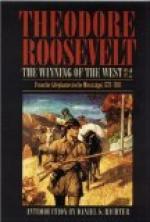Still, the Indian war parties were often checked, or scattered; and occasionally one of them received some signal discomfiture. Such was the case with a band that went up the Kanawha valley just as Clark was descending the Ohio on his way to the Illinois. Finding the fort at the mouth of the Kanawha too strong to be carried, they moved on up the river towards the Greenbriar settlements, their chiefs shouting threateningly to the people in the fort, and taunting them with the impending destruction of their friends and kindred. But two young men in the stockade forthwith dressed and painted themselves like Indians, that they might escape notice even if seen, and speeding through the woods reached the settlements first and gave warning. The settlers took refuge on a farm where there was a block-house with a stockaded yard. The Indians attacked in a body at daybreak when the door was opened, thinking to rush into the house; but they were beaten off, and paid dear for their boldness, for seventeen of them were left dead in the yard, besides the killed and wounded whom they carried away. [Footnote: McKee was the commander at the fort; the block-house was owned by Col. Andrew Donelly; Hanlon and Prior were the names of the two young men. This happened in May, 1778. For the anecdotes of personal prowess in this chapter see De Haas, or else Kercheval, McClung, Doddridge, and the fifty other annalists of those western wars, who repeat many of the same stories. All relate facts of undoubted authenticity and wildly improbable tales, resting solely on tradition, with exactly the same faith. The chronological order of these anecdotes being unimportant, I have grouped them here. It must always be remembered that both the men and the incidents described are interesting chiefly as examples; the old annalists give many hundreds of such anecdotes, and there must have been thousands more that they did not relate.] In the same year a block-house was attacked while the children were playing outside. The Indians in their sudden rush killed one settler, wounded four, and actually got inside the house; yet three were killed or disabled, and they were driven out by the despairing fury of the remaining whites, the women fighting together with the men. Then the savages instantly fled, but they had killed and scalped, or carried off, ten of the children. Be it remembered that these instances are taken at random from among hundreds of others, extending over a series of years longer than the average life of a generation.
The Indians warred with the odds immeasurably in their favor. The Ohio was the boundary between their remaining hunting-grounds and the lands where the whites had settled. In Kentucky alone this frontier was already seventy miles in length. [Footnote: Virginia State Papers, I., 437. Letter of Col. John Floyd. The Kentuckians, he notices, trust militia more than they do regulars.] Beyond the river stretched the frowning forest, to the Indians a sure shield in battle, a secure haven in disaster, an impenetrable mask from behind which to plan attack.




